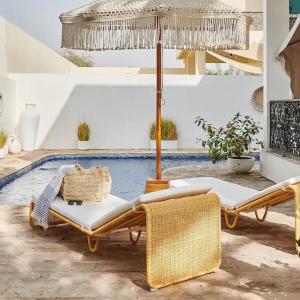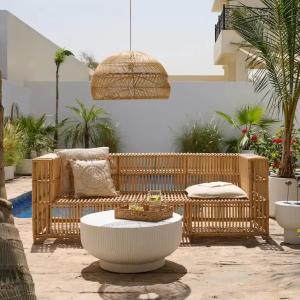Design and Comfort Merge in Modern Outdoor Daybeds Crafted from High-Quality Rattan
Elegant Outdoors: Explore Comfortable Beach Club Seating and Daybeds
DUBAI, AL MANARA, UNITED ARAB EMIRATES, October 8, 2025 /EINPresswire.com/ -- The modern approach to outdoor environments has shifted dramatically over the past decade. What was once a purely functional area for short stays and minimal amenities has evolved into a central element of architecture and design. Whether in private residences, hotels, or public resorts, outdoor zones are expected to deliver the same level of comfort and aesthetic coherence as interior spaces. Among the essential features defining this transformation are Outdoor daybeds, which combine ergonomic design, material durability, and an understanding of how people interact with space.The Role of Comfort in Contemporary Hospitality
The emphasis on comfort in hospitality environments stems from a clear understanding of human behavior. Visitors no longer come to a beach club or terrace simply to enjoy the view; they expect an atmosphere that supports genuine relaxation. Research in environmental psychology confirms that physical comfort directly affects emotional wellbeing and influences how long guests remain in a particular space. Well-designed Outdoor daybeds allow the body to rest naturally, reducing muscle tension and promoting full relaxation.
This understanding has changed how designers and venue owners think about furniture. No longer secondary to aesthetics, ergonomics is now a central component of the planning process. Factors such as seat height, backrest angle, and cushion density are carefully considered to accommodate different body types and sitting positions. When combined with climate-resistant materials, these design features ensure that guests can enjoy outdoor leisure for hours without discomfort.
Comfort is not just a physical sensation; it also shapes perception. Studies show that first impressions within hospitality venues are formed in under five minutes, and tactile experience is a major contributor. Furniture that feels stable, well-proportioned, and supportive immediately conveys attention to detail. In contrast, unstable or cheaply made items quickly diminish trust in the overall quality of service.
Materials and Durability
The coastal environment presents unique challenges: high humidity, intense sunlight, and salt exposure accelerate material degradation. Selecting the right furniture materials is therefore both a technical and aesthetic decision. Designers increasingly rely on high-quality rattan to meet these requirements. Rattan, whether natural or synthetic, provides a combination of strength, flexibility, and visual warmth that few other materials can match.
Natural rattan, long used in tropical regions, offers a tactile authenticity and organic texture valued in contemporary outdoor design. However, it requires regular maintenance to prevent drying or cracking. Synthetic rattan—engineered from high-grade polymers—has become the preferred solution for many coastal projects. It retains the woven texture of natural fibers while resisting moisture, UV radiation, and temperature fluctuations. This balance between natural aesthetics and technical performance allows Outdoor daybeds to maintain their form and color through years of intensive use.
The framework supporting rattan structures is equally important. Aluminum and stainless steel are the most common bases for modern outdoor furniture. Powder-coated aluminum combines lightness with corrosion resistance, making it suitable for large modular elements that need to be moved or rearranged. Stainless steel, though heavier, provides unmatched stability and endurance for high-traffic commercial zones.
Durability also extends to textiles. Outdoor upholstery now incorporates quick-dry foams and UV-stable fabrics that withstand rain, salt, and prolonged sun exposure. Detachable covers make cleaning simple and enable seasonal aesthetic changes without replacing the entire unit.
Design Principles for Outdoor Daybeds
Designing an Outdoor daybed is a complex process that balances visual language, ergonomics, and spatial context. The geometry of the piece influences how users perceive space. Rounded lines promote relaxation and softness, encouraging people to recline and linger, while angular shapes communicate modernity and order. Proportions are crucial: furniture that is too large dominates a terrace, while undersized pieces disrupt visual balance and reduce comfort.
Material selection directly informs the design vocabulary. High-quality rattan allows for both minimalist and expressive forms. Its woven pattern introduces texture that interacts beautifully with light and shadow, a feature particularly valued in open coastal settings. Designers often integrate neutral fabrics and subtle wooden or metallic accents to achieve harmony between structure and environment.
The prevailing trend in contemporary outdoor design is toward naturalism and authenticity. Boho style embodies this philosophy, emphasizing craftsmanship, layered textures, and the use of organic materials. In Boho-inspired lounges, rattan weaves, raw wood, and linen fabrics coexist in warm tones reminiscent of sand, clay, and sun-bleached driftwood. The goal is to create an environment that feels spontaneous yet balanced—an aesthetic that complements the rhythms of nature rather than competing with them.
Functionality and Spatial Planning
Outdoor furniture is not static; it defines how people move and interact. In beach clubs and resorts, Outdoor daybeds are often arranged in modular configurations, allowing staff to adapt layouts for different occasions—daytime lounging, sunset gatherings, or private events. This flexibility supports operational efficiency and guest comfort simultaneously.
Benches and modular sofas play a similar role, providing transition points between open and intimate zones. In designing these areas, proportional relationships are vital: the width of pathways, the spacing between elements, and visual sightlines all contribute to a coherent flow. Furniture becomes both a spatial divider and a connector, guiding visitors intuitively through the environment.
For example, benches positioned along the shoreline can serve as subtle boundaries between swimming areas and dining terraces, while integrated seating near bars encourages social interaction. Well-planned outdoor zones create micro-environments where guests can choose between solitude and sociability without perceiving a sharp division.
Maintenance and Longevity
The lifespan of outdoor furniture depends as much on maintenance as on design quality. Regular care routines prevent premature wear and preserve visual appeal. Simple steps—such as removing sand and salt residues, tightening fasteners, and covering items during storms—extend usability significantly.
Outdoor daybeds with textile components require special care. Cushions and mattresses should be periodically aired, and covers washed according to manufacturer recommendations. Applying water-repellent sprays once or twice a season enhances protection against stains and moisture. Metal parts benefit from occasional anti-corrosion treatments, while rattan surfaces should be cleaned with soft brushes and neutral detergents to avoid damage to the weave.
Many hospitality operators schedule maintenance tasks seasonally. A practical plan includes daily cleaning, weekly inspections for stability, monthly deep cleaning, and comprehensive end-of-season evaluations. Such procedures reduce long-term costs and ensure that the aesthetic and structural integrity of furniture remain consistent year after year.
Environmental Responsibility
Sustainability is no longer an optional feature—it has become a defining value of contemporary design. The choice of materials and production processes reflects an establishment’s commitment to environmental responsibility. Furniture made from renewable resources or recycled components not only minimizes ecological impact but also aligns with global hospitality trends emphasizing conscious consumption.
High-quality rattan fits well into this sustainable framework. Derived from rapidly renewable plants or eco-friendly synthetics, it provides durability without contributing to deforestation. When sourced from certified suppliers, rattan supports fair-trade practices and sustainable forestry initiatives.
Boho style further reinforces the sustainable narrative through its appreciation of natural imperfections and handcrafted details. Instead of polished uniformity, Boho-inspired designs celebrate texture variations and artisanal techniques, reducing reliance on energy-intensive manufacturing. This philosophy resonates strongly with environmentally aware travelers who seek authenticity and ethical production.
The integration of sustainable materials also has measurable business benefits. Durable, weather-resistant furniture reduces replacement frequency, decreasing both waste and long-term expenditure. Moreover, eco-friendly environments enhance brand reputation, appealing to clients who prioritize sustainability in their lifestyle choices.
Aesthetic Coordination and Visual Harmony
A cohesive visual identity is essential for any outdoor environment. Designers often draw upon color psychology to set the desired tone. Coastal projects typically favor palettes derived from nature: muted blues, sandy beiges, and soft whites create a sense of serenity and continuity with the surroundings. However, selective use of accent tones—such as terracotta, sage green, or charcoal—adds depth and individuality.
Texture layering plays an equally significant role. The contrast between smooth surfaces, woven rattan, and soft upholstery generates tactile richness that engages the senses. Lighting design enhances these effects, emphasizing patterns and contours after sunset.
Boho style compositions often employ an abundance of decorative elements—pillows, throws, rugs, and natural fiber accessories—to achieve a sense of informal luxury. Yet even within this aesthetic, restraint and balance are crucial. The goal is harmony rather than excess, ensuring that each element contributes to a unified visual statement.
Economic Impact and Long-Term Value
Investing in durable, well-designed outdoor furniture yields tangible economic benefits. Although the initial cost may be higher, the longevity of Outdoor daybeds and other high-quality seating significantly reduces replacement and repair expenses. Studies conducted within the hospitality sector reveal that guests spend more time and money in environments that offer physical comfort and aesthetic pleasure.
Furniture also functions as a branding instrument. Consistent design language communicates professionalism and reliability, influencing how guests evaluate overall service quality. Venues that prioritize comfort and design coherence report higher customer loyalty and increased social media engagement.
From a management perspective, durable furniture simplifies operations. Pieces made from high-quality rattan and corrosion-resistant metals require minimal upkeep, freeing staff for other duties. Modular configurations allow quick reorganization of space to accommodate different occupancy levels or event formats.
The psychological effect of a well-appointed environment is equally important. Visitors subconsciously associate comfort with competence; therefore, design quality enhances perceived value. Many businesses use this association to justify moderate price increases without alienating their clientele.
The Broader Design Context
The growing attention to outdoor design reflects a wider cultural trend toward blending architecture with landscape. As cities become denser, outdoor areas provide essential contact with nature and open space. In this context, Outdoor daybeds are more than furniture—they are instruments of lifestyle. They facilitate rest, socialization, and reconnection with the environment.
Architects and designers now treat exterior zones as continuous extensions of indoor layouts, employing similar design principles of proportion, rhythm, and material unity. The same visual coherence that defines interior comfort is carried seamlessly outdoors, resulting in a holistic spatial experience.
Technological innovation continues to influence this evolution. Advances in material science have made it possible to produce lightweight, recyclable components with high mechanical strength. Digital modeling tools enable designers to test ergonomics and durability virtually, reducing waste during prototyping. Combined, these innovations make it easier to create furniture that is both sustainable and timeless.
Conclusion
The transformation of outdoor living marks a broader redefinition of comfort and design. The fusion of ergonomic intelligence, material innovation, and aesthetic sensitivity allows modern spaces to fulfill both functional and emotional needs.
Within this landscape, Outdoor daybeds occupy a central role. They embody the principles of balance—between nature and technology, durability and elegance, individuality and coherence. Crafted from high-quality rattan and often inspired by Boho style, these pieces represent the meeting point of sustainability, craftsmanship, and contemporary design thinking.
As hospitality and residential projects continue to evolve, the importance of durable, comfortable, and visually harmonious outdoor furniture will only increase. The success of any leisure space—whether a private terrace or a public beach club—depends not on excess, but on thoughtful simplicity. In that sense, the modern outdoor environment is a reflection of a larger cultural aspiration: to live beautifully, responsibly, and in harmony with the world around us.
Carol Sukkar
Home and Soul Furniture Trading LLC
+971 56 112 1444
email us here
Visit us on social media:
LinkedIn
Instagram
Facebook
X
Legal Disclaimer:
EIN Presswire provides this news content "as is" without warranty of any kind. We do not accept any responsibility or liability for the accuracy, content, images, videos, licenses, completeness, legality, or reliability of the information contained in this article. If you have any complaints or copyright issues related to this article, kindly contact the author above.



